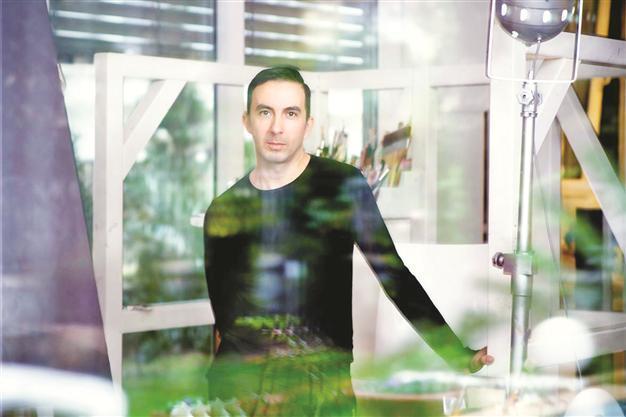A story of finding identity and success in the art world
ISTANBUL - Hürriyet Daily News

Taner Ceylan’s paintings may be read as taking different themes from life, such as love, pain, social life, hope, identity and reality. He may use an apron, a painting hanging on the wall, a photograph, or furniture of the period, or set his paintings
in the setting of an existing period photograph.
When, in 1995, famous Turkish contemporary artist
Taner Ceylan presented his first performance piece, titled “The Monte Carlo Style,” he invited
Istanbul’s high society to a “fake” party, at which he showed his own paintings. Ceylan calls this moment the “breaking point” of his art life. He made the show with a few friends, dressed flamboyantly, with makeup, and by the end of the performance he had sold all of his paintings. “This was the breaking point of my art life. I was in the market for five years and did not sell anything, and at last decided to do something like this with a few friends. We made fake invitations and invited everyone.”
After the show, Ceylan decided to stay in Istanbul, not to go to Germany, and continued to create artwork. The show made a tremendous impression among the art world and entered art history books as a one of a kind performance. “If you are doing something like this, it means that you have no expectations. I took a risk,” Ceylan said in an interview with the Hürriyet Daily News.
Now that he has sold paintings for as much as 300,000 pounds at auction and is included in famous collections, Ceylan’s works are currently flowing internationally. Ceylan says reaching this point was not easy. “I have done many jobs. I was an academic at Yeditepe University, but I realized that institutions are no place for me. It is almost impossible for an institution to handle my paintings.”
Ceylan’s painting series of 1997 and 2009 are striking and bold, reflecting Ottoman culture, eroticism, love, beauty, sexual seductiveness, exoticism, and pornography. His paintings may be read as taking different themes from life, such as love, pain, social life, hope, identity and reality. These paintings are the reflection of Ceylan’s inner world and desires, which he discovered over time.
“I graduated from the art academy in 1991. Until 1990 I was the best student. I was drawing figuratively, but focusing on form.” In his last year at the academy Ceylan discovered his real identity.
“It was very hard for me to accept.” That’s when his drawings changed and he began to depict homoerotic scenes in his paintings. “For many years galleries in
Turkey knew me as an artist who made erotic paintings. Most of them asked me why I never draw women figures. After I began to work with Galerist, my whole life changed.”
Ceylan became the artist who sold the most, and an artist whose pieces were selected for unique collections.
A time of change“I feel that I have come to the end of the nudity in my paintings. I can’t say that I will never draw any nude figures. But as an artist you can never fool yourself,” Ceylan said, talking about his latest series, which he will be showing in
London by the end of 2012.
“Cage of Flesh,” which sold for 121,250 pounds at a Sotheby’s auction held April 26 in London, is one of the last paintings in Ceylan’s “Lost Paintings,” series. “Cage of Flesh” is a figure composition that is not completed. According to an interpretation of the painting written by Cüneyt Çakırlar of University College London and Serkan Delice of University of the Arts London, “Cage of Flesh” reflects the “soul” that is trapped in the flesh. The painting tells the story of the search of the lost body, which is denied or forgotten.
“In [the ‘Lost Paintings] series I tried to tell the opposite story, from that which Orientalism tells. There are many beautiful women, even whole harems, depicted in Orientalist paintings. But they have nothing to do with reality,” Ceylan said. All of these depicitions are of a fantasy world, he said. “Very few painters actually entered the harem. The paintings always reflected a fairytale. But when we visit Topkapı, we can see their rooms, which are only three meters square.”
The main inspiration for the “Lost Paintings” series came from Gülsün Karamustafa’s work titled “Fragmenting - Fragments.” In this work Karamustafa made tiles from paintings by Orientalist painters. “I began to think about how I could depict this world in painting. In 1995 put together an exhibition titled ‘Young Osman,’ and this was when I first depicted the homoerotic world of Ottoman culture.”
Death threats
However, reflecting the culture and combining it with his artwork was not an easy process for Ceylan. “My painting titled ‘1879,’ which depicts an Ottoman woman in front of the painting of Gustave Courbet’s painting ‘L’Origine du Monde’ (The Origin of the World), raised eyebrows in society. After the painting was exhibited, I received death threats. I lived under state protection for three or four months,” Ceylan said. It was a traumatic period for him.
This is why Ceylan is no longer considering exhibiting his paintings in Turkey. “I have never exhibited the whole ‘Lost Paintings’ series together. The first exhibition will take place in London by the end of this year.”
After the “Lost Paintings” series, Ceylan will start a new series titled “Gold Period,” in which he aims to reflect the “soul” and “being,” using allegorical language.


